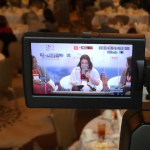VEI Advisory Board members Emma King, DES, vice president of learning and event strategy, INXPO; Amanda Marijanovic, DES, founder and chief creative officer, INNERACTION; and Lauren Benavente, DES, online meeting planner, EDUCAUSE, offer their best advice for working with a convention center or face-to-face venue to produce a hybrid event.
 Emma King
Emma King
Understanding the dedicated network/streaming capabilities of the venue needs to be one of the first items to focus on! If the venue doesn’t provide the dedicated bandwidth you need, then you will need to understand the costs of ordering upgrades, or, if necessary, changing the streaming delivery schedule of your hybrid event.
[pullquote class=“pullleft”]Sharing a Wi-Fi network with the hotel or other conventions taking place at the venue will result in challenges in streaming quality.[/pullquote]
Note that I said “dedicated”: Sharing a Wi-Fi network with the hotel or other conventions taking place at the venue will result in challenges in streaming quality. It is key to understand your networking landscape, so that you can design the hybrid component to work within the parameter of the physical venue.
 Amanda Marijanovic
Amanda Marijanovic
Know whether or not you’re dealing with a venue that falls under union jurisdiction. If so, a keen eye on special labor nuances is key. Be sure to read and carefully understand your contract. Your production partner can be a tremendous asset here, acting as your advocate when communicating with union stewards to ensure the most efficient and cost-effective game plan goes into play — meeting your hybrid’s needs while aligning with the necessary requirements. Shadow or “one-per-one” labor rules for AV roles and livestream technicians can wreak havoc on conservative budgets — and so can minimum crew-call times, overtime charges, and rigid meal-break rules. Be sure to budget your crew’s time and rates accordingly for setup and testing, rehearsals, and the actual livestream event.
[pullquote class=“pullleft”]The minimum acceptable speed is 1.5 mb/s, but the higher the speed, the better the video quality.[/pullquote]
In addition, livestreaming events open to the public can be considered a broadcast and therefore subject to added fees and even more strict union-labor regulations. Also important, of course, is the venue’s internet upload speed. The minimum acceptable speed is 1.5 mb/s, but the higher the speed, the better the video quality. During your site visit, you can easily test for yourself using a website like speedtest.net.
 Loren Benavente
Loren Benavente
Make sure everyone is on the same page. There is nothing worse than showing up on site to meet with your streaming provider only to find that the convention center has the wrong equipment setup. To prevent this from happening, make sure you organize at least a couple of calls beforehand where your streaming provider and convention-center contacts have an opportunity to talk through their needs and requirements. We’ve found that providing a document with detailed specifications helps to clarify questions and points of confusion. Never be afraid to get really specific and build good lines of communication early on in your hybrid-event planning process.
[pullquote class=“pullright”]We’ve found that providing a document with detailed specifications helps to clarify questions and points of confusion.[/pullquote]
For information about Digital Event Strategist (DES) certification, news about virtual and hybrid events, educational opportunities, a resource directory, and more, visit PCMA’s Virtual Edge Institute at virtualedgeinstitute.com.



